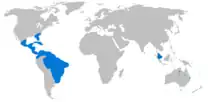| Telmatoblechnum serrulatum | |
|---|---|
.gif) | |
| Underside of frond | |
.gif) | |
| With Taxodium distichum | |
| Scientific classification | |
| Kingdom: | Plantae |
| Clade: | Tracheophytes |
| Division: | Polypodiophyta |
| Class: | Polypodiopsida |
| Order: | Polypodiales |
| Suborder: | Aspleniineae |
| Family: | Blechnaceae |
| Genus: | Telmatoblechnum |
| Species: | T. serrulatum |
| Binomial name | |
| Telmatoblechnum serrulatum | |
 | |
| Swamp Fern Range[1] | |
| Synonyms[2] | |
|
List
| |
Telmatoblechnum serrulatum, the toothed midsorus fern, is a species of fern in the family Blechnaceae, native to Florida, southeastern Mexico, Central America, the Caribbean, northern and western South America, Brazil, Paraguay, and northeastern Argentina.[2]
Ecology and habitat
The species is commonly found in freshwater marsh and swamp conditions in tropical or subtropical locations. It can also be found wet prairies, moist pine woods, and sometimes in forests[3] Specifically, in Florida the recorded habitat for this fern is moist and shady places.[4] The range for this fern species is from Florida to South America and has been recorded in Malaysia and Australia.[3]
It has shown good resistance to lead contamination when growing on coal mine tailings.[5]
Description
This fern is comparable to other ferns that consist of a stipe growing from the rhizomes and pinnae growing from the rachis.[3] The entire above-ground specimen is called the frond. The fronds for this species are monomorphic and typically are about 30-50 cm in length and 7-16 cm wide.[3] This means that this fern can grow a bit more than four feet tall. At the base, the stipe is usually light brown, sometimes darker at the base, typically 10-70 cm long, and appears cylindrical.[3] The rhizomes form horizontally, even sometimes climbing tree trunks, and are covered in dark brown scales.[3] There is the presence of spores which are located on the underside of the pinnae, usually tan to brown in color. Additionally, there is a central costa that runs the length of the pinnae.[3]
Conservation
This fern species has not been evaluated for conservation measures.[6] However, this species has been utilized for wetland restoration projects.[4]
References
- ↑ "GBIF".
- 1 2 Hassler, Michael (2023). "Telmatoblechnum serrulatum (Rich.) Perrie, D.J.Ohlsen & Brownsey; Taxon 63(4): 755 (2014)". worldplants.de. World Ferns. Synonymic Checklist and Distribution of Ferns and Lycophytes of the World. Version 15.2. Retrieved 13 April 2023.
Name: Swamp Fern, Saw Fern, Toothed midsorus fern (EN)
- 1 2 3 4 5 6 7 [ Rolleri, C. H., Prada, C., Gabriel y Galán, J. M., Passarelli, L. M., & Ciciarelli, M. M. (2010). Morphology of the sporophyte and gametophyte of the swamp fern, Blechnum serrulatum (Blechnaceae, Pteridophyta). Australian Journal of Botany, 58(6), 508. https://doi.org/10.1071/bt09238]
- 1 2 Florida Native Plant Society
- ↑ Andreola, Ariane; Rosini, Daniely Neckel; Campos, Mari Lucia; Biasi, Josieli Pietro; Citadini-Zanette, Vanilde; Da Costa Bortoluzzi, Roseli Lopes; Miquelutti, Davi José; Nicoleite, Edilane Rocha (2022). "Ferns and lycophytes in coal mining waste and tailing landfills". Environmental Science and Pollution Research. 29 (22): 32415–32427. doi:10.1007/s11356-022-18894-9. PMID 35167024. S2CID 234825355.
- ↑ Cambridge Botantic Garden